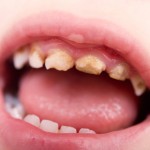
Developmental defects of enamel (DDE) result from cellular disturbances during enamel formation and maturation. The prevalence of DDE has been reported to range from 3.9-81.5% in primary teeth. Some types of DDE may increase susceptibility to dental caries and the association between DDE and caries may be underestimated.
This systematic review addressed the question ‘is there an association between developmental defects of enamel and dental caries in primary dentition?’
Methods
An electronic search using PubMed, Web of Knowledge, Scopus and Scielo was conducted by two researchers and compared between the two. A hand search of the articles’ reference lists was also undertaken, supervised by a third reviewer.
The authors included observational studies investigating the association between developmental defects of enamel and dentinal caries in the primary dentition. Animal studies, letters to the editor, reviews and studies with subjects which were institutionalised, of a vulnerable population or the sample selection was performed according to researcher interest were excluded, along with any studies not in English, Spanish or Portuguese.
The study quality was scrutinised using critical appraisal check list from the Joanna Briggs Institute. A flow chart is included which shows the progression of the studies through the systematic review and meta-analysis. Most of the pulled studies (19) were excluded as they did not evaluate the relationship between dental caries and enamel defects. 3 were excluded by design and 1 was not available, however the authors do not elaborate on why it was not available. Bias was tested using a funnel plot and Egger test.
This showed 8 studies were of high quality, 9 of moderate and 1 of low. This however does not analyse bias.
Results
- The initial search identified a total of 332 studies. Only 18 were included in the systematic review and 16 in the meta-analysis. There is no explanation of why 2 studies did not meet the criteria to be included in the meta-analysis. This meant a total of 11, 126 children were included.
- Eight of the included studies were considered to be of high quality, 9 of moderate and 1 of low.
- Of the studies included in the systematic review only 6 had results which were adjusted for factors such as socioeconomic status, oral hygiene and/or diet. 12 of the studies were from low-income countries with 4 from high income countries. One studies included results from two countries so the results were analysed separately.
- Meta-analysis suggests that children with developmental defects of enamel had higher odds of having dental caries Odd Ratio (OR) = 3.32 (95%CI; 2.41–4.57), with high heterogeneity between studies (I2 80%).
- Odds for higher caries experience for different types of enamel defect are shown in the table.
| Type of defect | Odds Ratio (95%CI) |
| diffuse opacities | 1.42 (1.15–1.76) |
| hypoplasia | 4.28 (2.24–8.15) |
| demarcated opacities | 2.62 (0.85–8.12) |
- The Egger test suggests a degree of publication bias.
Conclusions
The authors concluded: –
This systematic review and meta-analysis demonstrates a clear association between developmental defects of enamel and dental caries in the primary dentition.
Comments
The authors are forthcoming with the limitations of their systematic review and meta-analysis, although there is some missing information. Initially, the authors state that results from studies included was from “a representative sample of children”. They did not however explain what this meant; were children who were medically compromised included along with healthy children? They did not include any unpublished studies and so could this have disregarded a negative relationship between DDE and caries?
Most studies were conducted in low socioeconomic countries and so are more likely to be high caries risk, children are more likely to present with infection, nutritional deficiency and mothers are at a greater chance of having problems during pregnancy. These are all factors implicated in enamel defects and so we are likely seeing a skewed view.
Studies included in the meta-analysis are mostly cross sectional (only 2 out of 16 were cohort) and so no control group was available to compare. Most studies were not adjusted for factors such as oral hygiene, diet, fluoride level in drinking water or socioeconomic status and so it is seen that the odds ratio in these unadjusted studies is greater than the average.
Children included in the study are of a wide age range (6 months to 13 years) and so of course it is likely primary teeth in an older patient would be more likely to suffer from caries purely due to time exposed to sugar in diet. There is no mention of diagnosis of enamel defects, purely clinical presentation, and so I wonder if patients who present with enamel defects as a result of fluorosis may exhibit a different result.
Overall the meta-analysis was conducted well; however, the evidence available is of poor quality and perhaps at risk of bias.
Implications for practice
It is worth considering whether these results can be compared with our population. These results were overall collated from studies conducted in low socioeconomic countries and so may not be applicable in the UK.
After considering the results of this study, we should contemplate whether we do see a number of enamel defects within our clinical experience which are masked by caries. We should be informing our patients/parents of the presence of an enamel defect in their child’s tooth regardless and the likely increased vulnerability to decay. The clinician should ensure these patients are enrolled on a rigorous enhanced prevention programme.
Links
Primary paper
Costa FS, Silveira ER, Pinto GS, Nascimento GG, Thomson WM, Demarco FF. Developmental defects of enamel and dental caries in the primary dentition: A systematic review and meta-analysis. J Dent. 2017 May;60:1-7. doi:10.1016/j.jdent.2017.03.006. Epub 2017 Mar 24. Review. PubMed PMID: 28347809.
Other references
Joanna Briggs Institute Critical Appraisal tools
Dental Elf – 29th May 2015
Developmental defects of enamel and caries are they associated?
